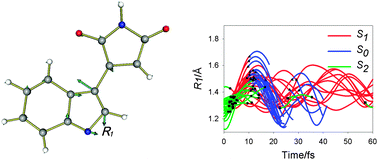Photochemical dynamics of indolylmaleimide derivatives†
Abstract
On-the-fly nonadiabatic ab initio molecular dynamics simulations have been carried out for three anionic species of indolylmaleimides (

Maintenance work is planned for Wednesday 1st May 2024 from 9:00am to 11:00am (BST).
During this time, the performance of our website may be affected - searches may run slowly and some pages may be temporarily unavailable. If this happens, please try refreshing your web browser or try waiting two to three minutes before trying again.
We apologise for any inconvenience this might cause and thank you for your patience.
* Corresponding authors
a
Department of Materials and Life Sciences, Faculty of Science and Technology, Sophia University, 7-1 Kioi-Cho, Chiyoda-ku, Japan
E-mail:
shinkoh.nanbu@sophia.ac.jp
b Graduate School of Pharmaceutical Sciences, Kyushu University, 3-1-1 Maidashi, Higashi-ku, Japan
c P. N. Lebedev Physical Institute, Leninsky pr., 53, Moskow 119991, Moscow Institute of Physics and Technology, Institutsky per., 9, Dolgoprudny, Russia
d Fukui Institute for Fundamental Chemistry, Kyoto University, 34-4, Takano-nishihirakicho, Japan
On-the-fly nonadiabatic ab initio molecular dynamics simulations have been carried out for three anionic species of indolylmaleimides (

 Please wait while we load your content...
Something went wrong. Try again?
Please wait while we load your content...
Something went wrong. Try again?
T. Murakami, M. Nakazono, A. Kondorskiy, T. Ishida and S. Nanbu, Phys. Chem. Chem. Phys., 2012, 14, 11546 DOI: 10.1039/C2CP41269A
To request permission to reproduce material from this article, please go to the Copyright Clearance Center request page.
If you are an author contributing to an RSC publication, you do not need to request permission provided correct acknowledgement is given.
If you are the author of this article, you do not need to request permission to reproduce figures and diagrams provided correct acknowledgement is given. If you want to reproduce the whole article in a third-party publication (excluding your thesis/dissertation for which permission is not required) please go to the Copyright Clearance Center request page.
Read more about how to correctly acknowledge RSC content.
 Fetching data from CrossRef.
Fetching data from CrossRef.
This may take some time to load.
Loading related content
